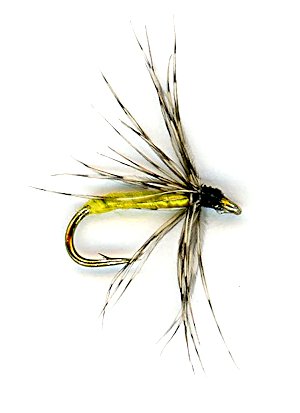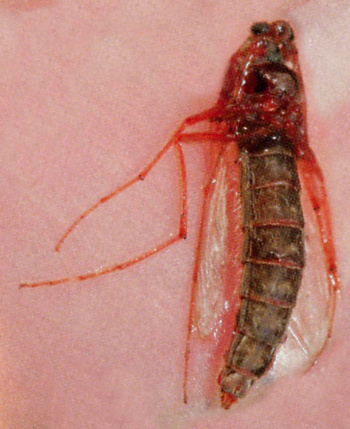Partridge & Yellow Soft Hackle
In Britain these soft hackle wet flies are called "Spiders" or "North Country" wet flies. Let me say first of all that these wet flies have NOTHING to do with imitating Spiders. It is a name they have been given over the years because when dry and out of the water the soft hackle looks like the legs of a large spider. These flies are over 300 years old.

SOFT HACKLE NORTH COUNTRY SPIDER WET FLY PATTERNS. Hook size 12 14 - $US each
Soft hackle wet flies are older than the United States of America and they still catch fish. The are not an imitation pattern. They are an impressionistic pattern. The soft hackle represents the legs and wings of a subsurface insect, but it is the movement in these flies that make them work
Soft hackled wet flies are extremely successful patterns on streams, rivers, lakes and reservoirs. the hackle responds to every movement of current as it is pulled through the water on the retrieve, thus suggesting to the fish this imitation is alive. The hackles are swept back over the hook as it is pulled through the water. They can suggest wings and legs of a hatched out insect, drowning or drowned, tumbled in the current. It can also imitate a struggling or swimming subsurface insect . In both cases the mobility of the hackle suggests life and food to the fish.

Trout do take static food like pupae in the surface film or spent spinners yet they also take subsurface food that is moving. Even the famous G.E.M. Skues in his classic book 'The way of trout with a fly' stresses the importance of movement in the design of flies. This maybe a strange concept to those fishermen who are dry fly purists who leave their flies to float dead adrift, but under the surface there is life and movement. Fly fishermen have to try and imitate that. A trout has the opportunities to investigate a static dry fly floating on the surface to see if it recognizes the silhouette as food.
A trout's recognition of a subsurface insect is not just on shape it is a combination of silhouette and swimming movement. When insects swim, their legs cling to their sides as they are propelled through the water. As their momentum slows their arms move forward to make the next stroke to propel them forward again. This is the exact movement duplicated by the soft hackles on a spider fly. As you retrieve the fly the hackles are forced back against the body of the fly and on the pause the hackles move forward again just like the real insect about to make another swimming stroke.
On a recent trip to the USA I found that North Country Spider wet flies were being sold in tackle shops under different soft hackle names. They were being marketed as some new revolutionary design. I had to laugh and some of the shop owners were upset when I informed them this pattern style was over three hundred years old and one of the oldest in the history of fly fishing.

During hatches of midges and olives the fish become preoccupied with eating as many emerging insects as they can. They catch them on their journey up to the surface, stuck as they emerge in the surface film and as they wait on the surface for their wings to dry before they fly off. I have found during a lull in the hatch if you use a buzzer, diawl bach or pheasant tail they sink too fast and most patrolling trout will not move down to attack an artificial fly. They are looking for their food in the top 12 inches of water. To keep your success rate up you must place your buzzer and rising nymph pattern in this zone. You need a pattern that does not sink as quick. This is where North Country Soft Hackle Spiders come into their own. They are such a good representation of nymphs and midges in the final stages of their assent to the water surface. The soft hackle acts like a parachute on its decent through the water column. The hackle has a high degree of water resistance which helps. When you see the fish 'bulging' they are taking food just below the surface. "Bulging" is the name given to the undersurface rising movement of fish that is visible to the fly fisher. If you look hard you will notice that the fish's mouths never break the surface.
When I first start fishing I use three different spider patterns as feeding fish cruise at different depths. This allows me to search for the correct pattern and it reduces the time it takes to catch the first trout. Once the fish has been spooned I then choose the pattern to match what the fish had been eating. I then fish three identical flies of the correct color match on the same cast to match the naturals they are taking. When fished 'wet' soft-hackled spiders perform best fished on the swing, slowly down and across in the current, in water that is slightly riffled. Add some floatant to the fly and try fishing them on the surface dead drift. The soft hackles resemble crippled or drowned mayflies. The amount of time that an insect is emerging is very brief, but it is a time when they are very vulnerable. Insects trapped in the surface film are like "fast food" for fish. An easy quick meal for a hungry trout.
Google+ Reader's Comment
These do very well in Yellowstone National Park in the fall. - Alan Hillard
Facebook Reader's Comment
Great dropper on back of steamer. I prefer the yellow body. Takes occur for me at end of swing when fly is suspended and immobile or after first tiny strip.- Chris Simonds USA
Facebook Reader's Comment
It work super on irish trout rivers - Irish Fishing Trips ltd
Facebook Reader's Comment
Works fine on the Au Sable, Manistee, Boardman and Jordan River in Michigan too.- Terry Drinkwine USA
Facebook Reader's Comment
The Partridge and Yellow Soft Hackle Wet Fly works great on the Loyalsock and Penns in Pennsylvania, and probably ever other stream in the state- Bob Krakowski USA
Facebook Reader's Comment
This fly is brilliant EVERYWHERE! With A Snipe and Purple and PTN on the point, fished across and down, it is sublime fishing. - Gregor Fulton McGregor HK


Fly Fishing books

